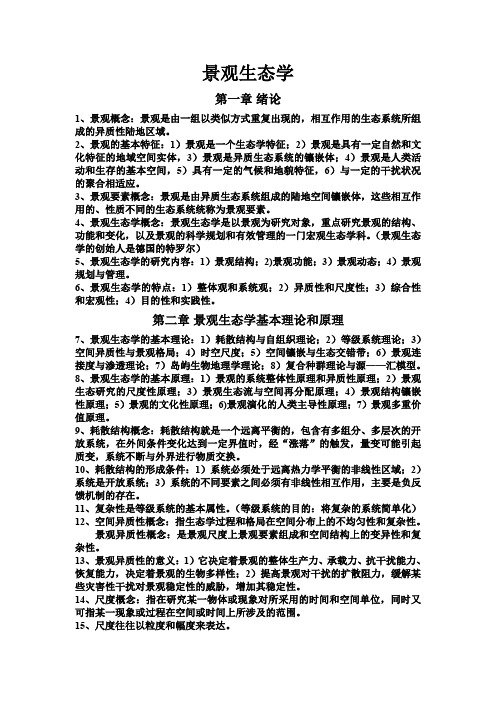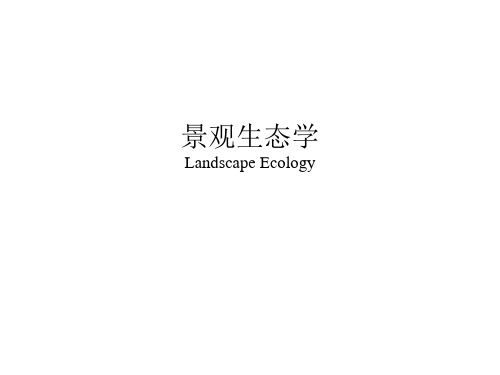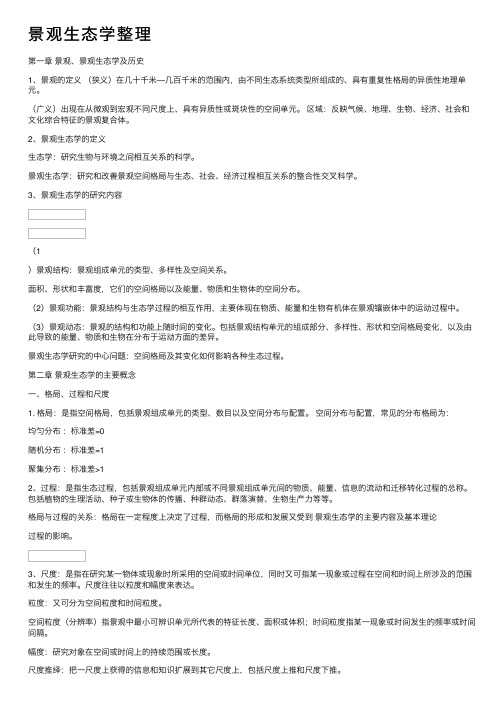安徽农业大学景观生态学第一部分2015
景观生态学_部分1(共计449页)

1 美学上的意义
景观(Landscape)一词的使用最早见于希伯 来语“圣经”旧约全书,原意是自然风光、 地表形态和风景画面。
汉语中的“景观”一词涵义丰富,反映 “风景、景色、景致”之意。
景观没有明确的空间界限,主要突出一 种综合直观的视觉感受。
景观的一般理解
常见的宏观景观举例
A.桂林山水景观; B.位于美国亚利桑那洲
大峡谷景观; C.美国威斯康辛大学
Curtis草地景观; D.内蒙古草原景观; E.北美的Sonoran
荒漠景观; F.亚洲温带
荒为科学名词被引人地理学,具 有地表可见景象的综合与某个限定性区域 的双重含义。
把地理学家研究自然现象的空间相互作用的横 向研究和生态学家研究一个生态区的机能相互作 用的纵向研究结合为一体,通过物质流、能量流、 信息流及价值流在地球表层的传输和交换,通过 生物与非生物以及人类之间的相互作用与转化, 运用生态系统原理和系统方法研究景观结构和功 能、景观动态变化以及相互作用的机理、研究景 观的美化格局、优化结构、合理利用和保护。
2、景观生态学的研究内容
1)、景观结构:斑块大小、形状、类型、异质
性、连接性,斑块间的空间关系
2)、景观功能:空间要素间的相互作用,如动物移
动、水分移动等。
3)、景观变化:结构和功能随时间的改变。
4)、景观规划与管理:制定景观恢复、保护、
建设和管理的计划和规划,确定相应的目标、措施与 对策。
3、景观生态学的特点
整体观和系统观 异质性和尺度性 综合性和宏观性 目的性和实践性
第三阶段由20世纪60年代后期到80年 代初,是学科的初创时期。
景观生态学讲解

题型:名词解释,填空,判断改错,简答,论述,计算景观生态学复习资料第一章绪论1.景观的定义(肖笃宁)景观是由不同土地单元镶嵌组成,具有明显视觉特征的地理实体,它处于生态系统之上,大地理区域之下的中坚持度,兼具经济、生态和文化的多重价值。
2.景观特征①间异质性②地域性③辨识性④可重复性和功能一致性等⑤具有一定的气候和地貌特征⑥各生态系统之间的物质能量流动和相互影响3.景观要素的定义景观是由不同生态系统组成的镶嵌体,其组成单元称之为景观要素。
景观强调的是异质镶嵌体,景观要素强调的是匀质同一的单元。
它们的关系是相对的。
4.景观和景观要素的相对关系(什么情况下景观可以转变成景观要素,什么时候景观要素)景观河景观要素的关系是相对的;景观强调的是异质镶嵌体,景观要素强调的是均质同一的单元;景观和景观要素之间的转换反映了景观问题和时间空间度密切相关例:5.景观的分类Forman按照景观塑造过程中的人类影响强度,划分了三种类型(1)自然景观(原始景观,轻度人为活动干扰)(2)经营景观(人工自然景观,人工经营景观)(3)人工景观(城市景观,水利工程,铁路,交通,湿地)6.景观生态学的概念景观生态学是研究景观单元的类型组成、空间配置及其占生态学过程相互作用的综合性学科。
也就是研究景观的结构、功能和变化多的一门综合性学科。
7.景观生态学国内外发展简史、流派(了解)一、国外发展史1.萌芽(19世纪初~20世纪30年代)首先生态学的出现,19世纪中期Haeckel把研究生物和环境关系的科学称之为生态学。
其后,从个体生态学发展到群落生态学。
1935年,英国生态学家坦斯提出了生态系统的术语。
2.巩固(20世纪30年代后期~60年代中期)1939年,德国著名的地植物学家特罗尔,在利用航片中研究东非土地利用问题时提出了景观生态学一词。
3.发展(20世纪60年代后期~80年代初,初步发展,20世纪80年代,全面发展)4.提高(20世纪90年代,学科的全面提高时期)二、国内发展史从80年代初开始,1989年10月初在沈阳召开首届景观生态学学术研讨会。
景观生态学

景观生态学:格局、过程、尺度与等级第一章景观生态学中的基本概念景观生态学:是研究景观单元的类型组成、空间配宜及其与生态学过程相互作用的综合性学科。
强调空间格局、生态学过程与尺度之间的相直作用是景观生态学研究的核心所在。
景观生态学研究的对象和内容:1.景观结构:即景观组成单元的类型、多样性及其空间关系。
2.景观功能:即景观结构与生态学过程的相互作用,或景观结构单元之间的相互作用。
3.景观动态:即指景观在结构和功能方而随时间的变化。
景观生态学中的格局:是指空间格局,广义的讲,它包括景观组成单元的类型、数目以及空间分布与配置。
过程:强调事件或现象的发生、发展的动态特征。
尺度:是指在研究某一物体或现象时所采用的空间或时间单位,同时又可指某一现象或过程在空间和时间上所涉及到的范囤和发生的频率。
尺度可分为空间尺度和时间尺度。
尺度往往以粒度和幅度来表达。
空间异质性;是指某种生态学变量在空间分布上的不均匀性及复杂程度。
空间异质性是空间缀块性和空间梯度的综合反映。
缀块性强调缀块的种类组成特征及空间分布与配置关系。
梯度指沿某一方向景观特征有规律地逐渐变化的空间特征。
生态学干扰:是指发生在一立地理位置上,对生态系统结构造成直接损伤的、非连续性的物理作用或事件。
生态学干扰由三个方而构成:系统、事件和尺度域。
、缀块:泛指与周困环境在外貌或性质上不同,并具有一迫内部均匀质性的空间单元。
如植物群落、湖泊、草原、农田或居民区等。
廊道:是指景观中与相邻两边环境不同的线性或带状结构。
如农田间的防风林带、河流、道路、峡谷、输电线路等。
基底:是指景观中分布最广、连续性最大的背景结构。
如森林基低、草原基低农田基底、城市用地基底等。
缀块•廊道•基底模式是基于岛屿与生物地理学和群落缀块动态研究之上形成和发展起来的。
它具体而形象地描述景观结构、功能和动态提供了一种“空间语言”。
第二章:景观格局的形成、结构和功能特征最观缀块类型(考过):分为四种1.残留缀块:由大面积干扰(如森林或草原大火、大范围的森林砍伐、农业活动和城市化等)所造成的、局部范围内幸存的自然或半自然生态系统或其片段。
景观生态学-复习题-参考答案

景观⽣态学-复习题-参考答案》复习题景观⽣态学》《景观⽣态学第⼀章景观⽣态学中的基本概念1.什么叫景观?答:景观是地球上⼀个由不同⼟地覆盖单元镶嵌组成,具有明显视觉特征的地理实体(⼀块⼟地);它处于⽣态系统之上,⼤地理区域之下的中间尺度,根据研究内容的不同,⾯积⼤⼩在数公顷⾄数万平⽅公⾥之间;兼具⾃然、经济、⽣态和⽂化的多重价值。
2.什么叫景观⽣态学?答:发⽣在的⽣态学。
景观⽣态学是以景观整体为研究对象的⽣态学分⽀,综合研究景观或景观组分的空间结构、⽣态过程、⽣态功能和动态变化的多学科交叉综合性学科。
3.景观⽣态学研究的内容是什么?答:研究景观的研究内容包括:(1)景观结构(2)景观⽣态过程和景观功能(3)景观变化(4)景观管理。
4.德国科学家C.Troll在景观⽣态学界的贡献是什么?为什么20世纪70年代以后,⼈们会重提他的科学贡献?答:Troll研究东⾮⼟地利⽤的时候,⾸次(1939年)提出景观⽣态这个术语,⽤以分析⼀个地区不同地域单位的⾃然-⽣物综合体的相互关系。
20世纪70年代以后,地球⽣态破坏、环境污染⽇趋严重,⼈们寻找解决这⼀⽣态环境问题的时候,确认Troll的⾃然-⽣物综合体的思想具有指导意义,因⽽重提他的科学贡献。
5.IALE的含义是什么?答:国际景观⽣态学会。
6.什么叫景观异质性?答:异质性指⼀个区域内,景观或景观组分在时间上和空间上的变异程度。
变异越⼤,异质性越⾼。
7.为什么说,尺度是景观异质性的⼀种限定或者条件?答:因为异质性与尺度是紧密相关的,尺度越⼤,景观的细节分辨率就降低,看起来就越模糊,景观就越趋于同质。
也就是说,景观异质性必须在特定的尺度(包括时间尺度和空间尺度)上才能度量,尺度是对异质性的⼀种限定或条件。
8.什么叫⽣态流?答:⽣态流指⽣景观或景观组分之间的物质、能量、物种、信息、价值的空间位移(迁移)过程。
9.⽣态流有那些类型?每个类型举出3个你熟悉的例⼦。
答:⽣态流包括能量流、物质流和物种流(以及信息流)。
(完整word版)景观生态学

景观生态学第一章绪论1、景观概念:景观是由一组以类似方式重复出现的,相互作用的生态系统所组成的异质性陆地区域。
2、景观的基本特征:1)景观是一个生态学特征;2)景观是具有一定自然和文化特征的地域空间实体,3)景观是异质生态系统的镶嵌体;4)景观是人类活动和生存的基本空间,5)具有一定的气候和地貌特征,6)与一定的干扰状况的聚合相适应。
3、景观要素概念:景观是由异质生态系统组成的陆地空间镶嵌体,这些相互作用的、性质不同的生态系统统称为景观要素。
4、景观生态学概念:景观生态学是以景观为研究对象,重点研究景观的结构、功能和变化,以及景观的科学规划和有效管理的一门宏观生态学科。
(景观生态学的创始人是德国的特罗尔)5、景观生态学的研究内容:1)景观结构;2)景观功能;3)景观动态;4)景观规划与管理。
6、景观生态学的特点:1)整体观和系统观;2)异质性和尺度性;3)综合性和宏观性;4)目的性和实践性。
第二章景观生态学基本理论和原理7、景观生态学的基本理论:1)耗散结构与自组织理论;2)等级系统理论;3)空间异质性与景观格局;4)时空尺度;5)空间镶嵌与生态交错带;6)景观连接度与渗透理论;7)岛屿生物地理学理论;8)复合种群理论与源——汇模型。
8、景观生态学的基本原理:1)景观的系统整体性原理和异质性原理;2)景观生态研究的尺度性原理;3)景观生态流与空间再分配原理;4)景观结构镶嵌性原理;5)景观的文化性原理;6)景观演化的人类主导性原理;7)景观多重价值原理。
9、耗散结构概念:耗散结构就是一个远离平衡的,包含有多组分、多层次的开放系统,在外间条件变化达到一定界值时,经“涨落”的触发,量变可能引起质变,系统不断与外界进行物质交换。
10、耗散结构的形成条件:1)系统必须处于远离热力学平衡的非线性区域;2)系统是开放系统;3)系统的不同要素之间必须有非线性相互作用,主要是负反馈机制的存在。
11、复杂性是等级系统的基本属性。
第1章-景观生态学的一般概念

90年代迅速发展,大量论文书籍出现。
肖笃宁、景贵和、 伍业钢、李哈滨、傅伯杰等 多有论文及论著。
29
四、景观生态学研究的对象和内容
1、景观结构:即景观组成单元的类型、多样性及其空间关 系。景观中不同生态系统(或土地利用类型)的面积、形状 和丰富度,它们的空间格局及能量、物质和生物体的空间分 布等,均属于景观结构类型。
12
景观最新定义(肖笃宁):景观是一个由不同土地单元 镶嵌组成,具有明显视觉特征的地理实体,它处于生态系统 之上,大地理区域之下的中间尺度;兼具经济、生态和文化 的多重价值。
综合起来,对景观可以作如下理解:①景观由不同空间 单元镶嵌组成,具有异质性;②景观是具有明显形态特征与 功能联系的地理实体,其结构与功能具有相关性和地域性; ③景观既是生物的栖息地,更是人类的生存环境;④景观是 处于生态系统之上,区域之下的中间尺度,具有尺度性;⑤ 景观具有经济、生态和文化的多重价值,表现为综合性。
临界阈理论和渗透理论
复合种群理论
地等级理论
斑块动态 人类活动和影响
格局 - 过程 - 尺度
33
五、景观生态学研究重点 1、空间异质性或格局的形成和动态及其与生态 学过程的相互作用; 2、格局—过程—尺度之间的相互关系; 3、景观的等级结构和功能特征以及尺度推绎问 题; 4、人类活动与景观结构、功能的相互关系; 5、景观异质性(或多样性)的维持和管理。
30
关系: 景观的结构、功能和动态时相互依赖、相互作用。任何
生态学组织层次上(种群、群落、生态系统和景观),结构 和功能都是相辅相成的。结构在一定程度上决定功能,而结 构的形成和发展又受到功能的影响。
一个由不同森林生态系统和湿地系统所组成的景观, 在物种组成、生产力以及物质循环诸方面都会显著不同于另 一个以草原群落和农田为主体的景观。
景观生态学第一章

LANDSCAPE ECOLOGY
干扰
干扰(disturbance):是一个偶然发生的不可预知的事件,是发生在一定地 理位置上,对生态系统结构造成直接损伤的、非连续性的物理作用或事件。 干扰的类型 按干扰产生的来源分:自然干扰和人为干扰 依据干扰的功能分:内部干扰和外部干扰 依据干扰的形成机制分:物理干扰、化学干扰和生物干扰 干扰的生态学意义 干扰与景观异质性 干扰与景观破碎化 干扰与物种多样性
LANDSCAPE ECOLOGY
学科的全面发展时期(开始于20世纪80年代初)
1982年10月在捷克斯洛伐克召开的“第六次景观生态学国际学术讨论会”上,正式 成立了“国际景观生态学会 (International Association for Landscape 国际景观生态学会” 国际景观生态学会 Ecology(IALE) .学会成立后,景观生态学的发展显示出三个特点:一是研究和教学活 动普遍化,二是国际学术活动频繁,三是出版物大量涌现。 研究活动普遍:美国70年代末才开始研究景观生态学,但发展极快。 美国景观生态学基本是继承生态学传统,强调景观生态研究的生物学基础,确立合理 的研究对象,将许多相关科学关于景观空间、和时间割据的知识统合成一个协调的整体, 以便更好的理解景观的行为。 10年间总结出景观生态学的原理,如Forman的7项原则;Risser关于景观尺度的5条 法则;
然地域综合体”的概念。 德国的地理学家Buchwald 认为,景观可以理解为地表某一空间的综合特征,包括景观
的结构特征和表现为景观各因素相互作用关系的景观流,以及人的视觉所触及的景观像、 景观功能及其历史发展。因此景观是一个多层次的生活空间,是一个由地圈生物圈组成的、 相互作用的系统。 前苏联的景观地理学 类型方向 区域方向 生物地理群落 地球化学景观 肖笃宁(1997)景观是一个由不同土地单元镶嵌组成,具有明显视觉特征的地理实体, 它处于生态系统之上,大地理区域之下的中间尺度。
景观生态学——专题一PPT课件

第19页/共42页
2.形成阶段(20世纪30年代后期~60年代中期) 1939年,德国著名的地植物学家特罗尔,
第4页/共42页
3. 景观是地球表面空间的一部分,是由岩石、水通过其外貌构成一个可识别的实 体( Zonneveld )。
4. 景观是连同其所有现象(地形、土壤、植被、 人为影响)的陆地表面;是具有特有的地形、 土壤、植被的陆地表面的一个区域;是相互有 关的几片土地的天然配置(Vink)。
参考书: 1. 郭晋平等. 景观生态学. 2007. 北京:中国林业出版社 2. 徐化成. 景观生态学. 1996. 北京:中国林业出版社 3. 傅伯杰, 陈利顶, 马克明, 王仰麟等. 2001. 景观生态学原理及应
用. 北京: 科学出版社 4. 邬建国. 2000. 景观生态学—格局、过程、尺度与等级. 北京:
11. Navel Z. and Lieberman AS. 1993. Landscape ecology: Theory and application (2nd edition). Now York: Springer-Verlag
12. Farina, A. 2000. Landscape Ecology in Action. Dordercht: Kluwer Academic Publishers
异质性是景观的基本属性,异质生态系统的空间构型、 空间配置和空间格局是景观结构的重要表现形式,也是决定 景观功能、过程及其变化的基础。
(4)景观是人类活动和生存的基本空间
景观生态学整理

景观⽣态学整理第⼀章景观、景观⽣态学及历史1、景观的定义(狭义)在⼏⼗千⽶—⼏百千⽶的范围内,由不同⽣态系统类型所组成的、具有重复性格局的异质性地理单元。
(⼴义)出现在从微观到宏观不同尺度上、具有异质性或斑块性的空间单元。
区域:反映⽓候、地理、⽣物、经济、社会和⽂化综合特征的景观复合体。
2、景观⽣态学的定义⽣态学:研究⽣物与环境之间相互关系的科学。
景观⽣态学:研究和改善景观空间格局与⽣态、社会、经济过程相互关系的整合性交叉科学。
3、景观⽣态学的研究内容(1)景观结构:景观组成单元的类型、多样性及空间关系。
⾯积、形状和丰富度,它们的空间格局以及能量、物质和⽣物体的空间分布。
(2)景观功能:景观结构与⽣态学过程的相互作⽤,主要体现在物质、能量和⽣物有机体在景观镶嵌体中的运动过程中。
(3)景观动态:景观的结构和功能上随时间的变化。
包括景观结构单元的组成部分、多样性、形状和空间格局变化,以及由此导致的能量、物质和⽣物在分布于运动⽅⾯的差异。
景观⽣态学研究的中⼼问题:空间格局及其变化如何影响各种⽣态过程。
第⼆章景观⽣态学的主要概念⼀、格局、过程和尺度1. 格局:是指空间格局,包括景观组成单元的类型、数⽬以及空间分布与配置。
空间分布与配置,常见的分布格局为:均匀分布:标准差=0随机分布:标准差=1聚集分布:标准差>12、过程:是指⽣态过程,包括景观组成单元内部或不同景观组成单元间的物质、能量、信息的流动和迁移转化过程的总称。
包括植物的⽣理活动、种⼦或⽣物体的传播、种群动态、群落演替、⽣物⽣产⼒等等。
格局与过程的关系:格局在⼀定程度上决定了过程,⽽格局的形成和发展⼜受到景观⽣态学的主要内容及基本理论过程的影响。
3、尺度:是指在研究某⼀物体或现象时所采⽤的空间或时间单位,同时⼜可指某⼀现象或过程在空间和时间上所涉及的范围和发⽣的频率。
尺度往往以粒度和幅度来表达。
粒度:⼜可分为空间粒度和时间粒度。
空间粒度(分辨率)指景观中最⼩可辨识单元所代表的特征长度、⾯积或体积;时间粒度指某⼀现象或时间发⽣的频率或时间间隔。
景观生态学

一、名词解释1、景观:景观具有广义与狭义概念。
其中广义:为从微观到宏观不同尺度上的、具有异质性或斑块性的空间单元。
狭义:指几十平方千米至几百平方千米范围内,由不同生态系统类型所组成的异质性地理单元。
2、景观要素:景观是由不同生态系统组成的镶嵌体,其每一个组成单元为景观要素。
3、景观生态学:以景观为研究对象,研究景观结构、功能、变化及其规划与管理的一门宏观生态学科。
4、斑块:外貌和属性与周围景观要素由明显区别,且在空间上可分辨的非线性景观要素。
5、廊道:不同与两边基质的狭长地带6、景观连接度:景观空间结构单元之间连通性的生物学度量指标(L/3(V-2))7、环度:网络中现有结点的环路存在程度。
(L-V+1/2V-5)8、基质:景观中面积最大、连通性最好、优势度最好的景观要素9、孔隙度:景观内具有闭合边界的斑块密度的两度,指单位面积上闭合边界里的斑块数目。
10、镶嵌性:指一个系统的组分在空间结构上互相拼接成一个整体。
11、景观格局:在某特定尺度上景观的空间结构特征,即空间格局。
指大小形状各异的景观要素在空间上的排列形式,或景观要素类型、数目及空间分布与配置等。
12、景观异质性:景观系统特征在空间、时间上的不均匀性和复杂程度。
13、景观生态过程:物质和能量在景观要素内部及其之间的流动引起的14、扩散:溶质物质或者悬浮物质从高浓度向低浓度移动的过程。
15、质量流动:物质沿能量梯度移动的过程。
16、运动:物体通过消耗自身能量从一处向另一处移动的过程。
17、景观生态流:指物质、能量、物种及其他信息在景观各空间组分中的流。
17、狭管效应:能量和物质在通过景观的狭窄地带时流速发生改变。
18、景观稳定性:景观保持原状态及其收到干扰后回归该状态的能力19、景观亚稳定性:受到一定干扰后发生变化并达到可预测波动状态。
20、景观不稳定性:波动方式经常发生变化或不可预测。
21、破碎化:一个生境或土地类型分解成小块生境或小地块的过程。
《景观生态学》讲义完整版

《景观生态学》讲义完整版绪论景观生态学作为地理学和生态学的交叉学科,具有独特的生命力和高度的综合性。
与自然保护、规划、景观设计、野生生物学、土地评价、地理学、环境科学、林学、农学等学科密切相关,尤其是目前的环境问题和社会问题与景观生态息息相关,有着广阔的前景。
每个人都处于景观中,其质量好坏息息相关。
本课程的学习方法在于:知识累积,思维方式的深化,一种能力,一种方法。
本课程的结构由以下几个部分组成:1、景观生态学的概念,内容,历史。
2、景观构成要素——嵌块体,廊道,基底。
3、景观的总体结构。
4、景观发育的自然过程。
5、人类对景观的影响。
6、景观的功能。
7、想念邻景观要素间的流动。
8、景观的动态。
9、景观的异质性和类型学。
10、土地景观分类(属性,景观,能力)11、土地评价。
12、景观的规划与管理。
第一章景观和景生态学第一节景观1、概念:英语中多含义,有美学的,文化的,地理,专业的,空间上:大尺度,小尺度(毛虫相片)1)美学的:景观大致均一的地区风景,直观景象,这个概念主要应用于景观建筑学,风景园林学。
2)地理学:是地球表面地貌、气候、土壤,生物所形成的综合体。
发生上是立的,是地表在地带性和非地带性方面最一致的地域地段,具有自己的形态,单位的质和量的对比关系,并以此与其相邻景观区别。
此概念充分反映了自然界的特点和天资的多样性,完整的土地利用单位。
景观生态学是由1919德国(TROLL)特罗尔首提,我国80年代初方开始国际上景观生态学的发展。
生态学:是在一(将)个相对均质的空间内研究植物、动物、大气、水、土壤之间的关系(生物之间,生物与环境之间)的科学。
是一个利用和改造的生态工程。
景观生态学:某一地区不同空间单元的自然环境与生物关系的科学。
若干个生态系统聚合所组成的异质性土地地域内的生物与自然环境之间关系的科学。
其优点在于:景观水平上,生态学研究的是整体观及许多本来缺乏联系的学科在解决景观问题上的综合。
景观生态学(083020).

景观生态学(083020)
学科门类:工学(08)一级学科:环境科学与工程(0830)
景观生态学学科属环境科学与工程一级学科。
景观生态学是以景观为研究对象的多学科科学,其研究内容广泛且方法多样。
我校景观生态学专业设置于2003年,目前已招收了相关的博士生。
景观生态学是目前发展最为迅速的生态学分支学科之一,该学科正在不断地发现和拓展其研究领域。
在我校该专业尚处于起步阶段,目前与该学科有关的博士生导师6人,教授11人,具有博士学位人员8人,近年来获国家及部省级科技进步奖数项,发表学术论文50余篇。
主要实验室有“浅水湖泊综合治理与资源开发教育部重点实验室”,重要设备有有机化学实验室、无机化学实验室、原子吸收光谱、计算机工作站等。
景观生态学在许多方面都能够得到应用,在土地利用管理、自然资源的开发利用、环境保护及区域发展规划中都涉及景观生态学。
一、培养目标
本学科培养景观生态方面的高层次人才。
本学科学生除了掌握数理化基础知识外,还要掌握扎实的地理学、生态学和景观规划与设计知识,掌握国内外景观生态学的最新成果。
能够解决环境保护问题和进行景观规划。
二、主要研究方向
1、城市生态学
2、景观生态模型
3、土地景观生态
4、景观管理与规划
三、课程设置
硕士研究生课程设置。
景观生态学 第一节

F.亚洲温带荒漠景观 一角
人类与自然共同作用影响下的不同景观
1.2 景观的定义和特征
1.2.1 定义 景观:是以类似方式重复出现的、相互作用的
若干生态系统的聚合所组成的异质性土地地域。 (1986,Forman & Godron) 例:“秦岭”
景观生态学:研究相关景观系统的相互作用、
空间组织和相互关系的一门学科,即研究由相互作 用的生态系统组成的异质地表的结构、功能和动态。
2、景观结构成分: 景观结构成分是生态学
和自然地理学性质各异、而形态特征和空间分布 特征相似的景观要素,是对景观要素从空间结构
的角度进行分析和考察时的重新划分。
划分景观结构成分的目的是为了更好地分析、 研究和理解景观要素在景观中的地位和作用。
组成景观的生态系统都是具有一定形态特征和分布特征的空间实体,由于 生态系统在景观中的空间形态特征和分布特征对它们在景观中的作用有明显影 响,与其他景观要素的相互作用也有差异。景观结构成分是生态学和自然地理 学性质各异、而形态特征和空间分布特征相似的景观要素,是对景观要素从空 间结构的角度进行分析和考察时的重新划分。 福尔曼将它们分为斑块(patch)、廊道(corridor)和基质(matrix), 称其为景观结构成分(Forman,1995b)。 斑块是外貌和属性与周围景观要素有明显区别且空间上可以分辨的非线性 景观要素。在一个林区景观中,斑块可以是一片森林、一片湿地、一个村庄、 或一片农田。
境中的历史文化、风土
民情、风俗习惯等与人
们精神生活世界息息相 关的文化因素,直接决
定着一个地区、城市、
街道的风貌。
二、是环境生态层,包括土地利用、地 形、水体、动植物、气候、光照等人文 与自然因素在内的从资源到环境的分析。
安徽农业大学景观生态学第三部分斑块2015

景观生态学Landscape Ecology第三部分景观格局一.斑块定义:指与周围环境在外貌和性质上不同,并具有一定内部均质性的空间单元。
强调斑块的空间非连续性和内部均质性。
·广义上,斑块可以是有生命的,也可以是无生命的;而狭义上,斑块仅指动植物群落。
·对景观异质性、动态、功能等的研究,实质上就是对斑块的性质、分布、组合及动态、功能的研究.1.斑块的起源和类型影响斑块起源的主要因素:环境异质性(environmental heterogeneity)自然干扰( natural disturbance )人类活动(human activity )Forman和Godron(1981,1986)根据斑块的起源或成因机制将常见的景观斑块,根据起源分为四类:干扰斑块(disturbance patch)残存斑块(remnant patch)引进斑块(introduced patch)环境资源斑块(environmental resource patch)1.1干扰斑块起源:自然干扰和人类干扰。
一般由短期局部性干扰形成;也可由长期持续干扰形成,主要是由人类干扰引起的;有时,长期自然干扰也能够形成干扰斑块。
特点:基质未受干扰,而斑块受到干扰。
种群大小、迁入率和灭绝率等在初始剧烈变化,随后进入平稳演替阶段;当基质和斑块融为一体时,干扰斑块消失具有最高的周转率(turnover rates) ,持续时间最短,通常是恢复最快的斑块类型。
但长期持续干扰斑块也能保持稳定,持续时间较长。
1.2残存斑块起源:基质受到大面积自然干扰和人类干扰的影响,在其局部范围内幸存的自然或半自然生态系统或其片断,其成因机制与干扰斑块相反。
特点:基质受干扰,而斑块未受到干扰。
种群大小、迁入率和灭绝率等在初始剧烈变化,随后进入平稳演替阶段;当干扰消失后,在自然界同化作用下能很快地融合在基质内,残存斑块消失。
具有较高的周转率。
- 1、下载文档前请自行甄别文档内容的完整性,平台不提供额外的编辑、内容补充、找答案等附加服务。
- 2、"仅部分预览"的文档,不可在线预览部分如存在完整性等问题,可反馈申请退款(可完整预览的文档不适用该条件!)。
- 3、如文档侵犯您的权益,请联系客服反馈,我们会尽快为您处理(人工客服工作时间:9:00-18:30)。
景观生态学Landscape Ecology●课程安排第一部分景观生态学的相关概念及发展第二部分景观生态学的理论框架第三部分景观格局第四部分景观生态过程及动态变化第五部分景观生态评价第六部分景观生态学应用第一部分景观生态学的相关概念及发展一.景观生态学相关概念辨析1、第一组概念景观: 景观是土地的具体一部分,代表一种更精细的尺度的含义;更强调供人类观赏的美学价值和作为复杂生命组织整体的生态价值及给人类带来的长期效益。
景观是构成环境的实体部分,既不是环境中所有要素的全部,也不是它们简单相加而成的整体,而是综合的产物。
风景:景观在美学意义上的概念。
包括自然风光、地表形态、风景画面等。
没有明确的空间界限,主要突出一种综合直观的视觉感受。
土地:土地概念侧重于社会经济属性,主要关注的是土地的生产力、土地的产权关系、土地的经济价值等。
环境:环绕于人类周围的客观事物的整体,包括自然因素和社会因素,它们既可以实体形式存在,也可以非实体形式存在。
●景观生态学中的景观✓地理空间概念(19世纪):A. von Humboldt自然地域综合体:景观是由各种具有空间位置的地理要素组成的地理复杂体(或称地理系统)。
✓生态过程思想(20世纪30年代以来):Call Troll(1)Naveh (1987): “landscape deal with in their totality as physical, ecological and geographical entities, integrating all natural and human patterns and processes…”.(2)Forman and Godron (1986): landscape as a heterogeneous land area composed of a cluster of interacting ecosystems that is repeated in similar form throughout.”(3)Leser (1997): regards the landscape ecosystem as a spatial pattern of abotic, biotic and anthropogenic components which form a functional entity and serve as human’s environment. (4)肖笃宁(1997):景观是一个由不同土地单元镶嵌组成,具有明显视觉特征的地理实体;它处于生态系统之上,大地理区域之下的中间尺度;兼具景观、生态和文化的多重价值。
✓狭义景观直觉地将景观看作基于人类范畴基础之上的特定区域,指在数十公里到数百公里范围内,由诸如林地、草地、农田、树篱和人类居住地等不同类型生态系统组成的异质性地理单元。
这也是我们通常所说的“景观”。
✓广义景观根据所研究的具体物种或生态学现象来定义,包括出现在从微观到宏观不同尺度上的,具有异质性或斑块性的空间单元。
广义景观概念最突出的特点就是体现了生态学系统中多尺度和等级结构的特征。
可以在所有这些尺度上运用景观生态学的原理和方法来研究问题,有助于多学科、多途径的研究。
这一概念越来越广泛的为生态学家所关注和采用。
●景观分类Forman按照按照人类活动对景观的影响程度将景观划分为自然景观、经营景观和人工景观。
自然景观:分为原始景观和轻度人为活动干扰的自然景观两类。
以保护为主。
管理景观:分为人工自然景观(植被被改造)与人工经营景观(土壤被改造)。
农田景观和城郊景观。
最重要的研究对象。
人工景观(或称人类文明景观):一种自然界原先不存在的景观,如城市、工矿和大型水利工程等,人类成为其中的主要生态组分。
2、第二组概念自然地域综合体:强调景观地域整体性,更强调景观的综合性,认为景观是由气候、水文、土壤、植被等自然要素及文化现象组成的地理综合体,这个整体空间典型的重复在地表的一定地域内。
生态景观:是社会—经济—自然复合生态系统的多维景观,包括自然景观(地理格局、水文过程、气候条件、生物活力)、经济景观(能源、交通、基础设施、土地利用、产业过程)、人文景观(人口、体制、文化、历史、风俗、风尚、伦理、信仰等)的格局、过程和功能的多维耦合,是由物理的、化学的、生物的、区域的、社会的、经济的及文化的组分在时、空、量、构、序范畴上相互作用形成的人与自然的复合生态体。
(王如松)3、第三组概念地貌植被土壤4、第四组概念●景观生态学的概念概念Forman,1983: Landscape Ecology…focuses on (1) the spatial relationships among landscape elements, or ecosystems, (2) the flows of energy, mineral nutrients, and species among the elements, (3) the ecological dynamics of the landscape mosaic through time.Risser et al., 1984: Landscape ecology focuses explicitly upon spatial patterns. Specifically, landscape ecology considers the development and dynamics of spatial heterogeneity , spatial and temporal interactions and exchanges across heterogeneous landscape, influences of spatial heterogeneity on biotic and abiotic processes, and management of spatial heterogeneity. Forman and Godron (1986), Landscape Ecology, John Wiley and Sons):“Landscape Ecology is the study of structure, function and change in a heterogeneous land area composed of interacting ecosystems.”Urban et al., 1987: Landscape ecology is motivated by a need to understand the development and dynamics of pattern in ecological phenomena, the role of disturbance in ecosystems, and characteristics spatial and temporal scales of ecological events.Turner, 1989: Landscape ecology emphasizes broad spatial scales and the ecological effects of the spatial patterning of ecosystems.Wiens et al., 1993: Landscape ecology deals with the effects of the spatial configuration of mosaic on a wide variety of ecological phenomena.Pickett and Cadenasso, 1995: Landscape ecology is the study of the reciprocal effects of spatial pattern on ecological processes; it promotes the development of models and theories of spatial relationships, the collection of new types of data on spatial pattern and dynamics, and theexamination of spatial scales rarely addressed in ecology.●景观生态学是✓一门新兴的生态学学科。
✓是多学科之间的交叉学科,主体是地理学与生态学之间的交错(multidisciplinarity, interdisciplinarity)。
✓以整个景观为对象。
✓研究景观的空间结构、功能、动态变化机理。
✓以达到景观美化格局、优化结构、合理利用和保护的目的。
●景观生态学主要特征综合的思想和方法:景观生态学的理论优势在于运用综合整体的思维,实现学科的交叉和创新。
以格局-过程-尺度之间的相互关系为核心。
更加关注较大的空间幅度。
强调人类活动对于格局、过程和变化的影响●景观生态学和生态系统生态学的比较景观生态学:空间异质性;景观镶嵌体;整体生态系统;自然生态系统和人文生态系统;对大领域活动的动物种群的研究;重视地貌、干扰及生态系统之间的相互关系生态系统生态学:同质性;垂直格局;分散的岛状系统;自然生态系统二、景观生态学的几个重要概念1.景观格局景观格局(Pattern):指景观组分的空间分布和组合特征,包括景观组成单元的类型、数目及空间分布与配置。
景观格局研究是景观生态学研究的基础。
景观格局的斑块特征、空间相关程度及详细格局特征可通过一系列数量方法进行研究。
2.景观格局镶嵌性镶嵌性:一个系统的组分在空间结构上相互拼接而构成整体。
镶嵌的特征:对象被聚集,形成清楚的边界,连续空间发生中断和突变。
斑块-廊道-基质模式斑块(Patch):指与周围环境在外貌和性质上不同,并具有一定内部均质性的空间单元。
廊道(Corridor):指景观中与相邻两边环境不同的线性或带状结构。
基质(Matrix):指景观中分布最广、联系性最大的背景结构。
斑块-廊道-基质模式有利于考虑景观结构和功能之间的相互关系,比较他们在时间上的变化。
斑块、廊道和基质的区分具有相对性。
3.尺度尺度(scale):指在研究某一物体或现象时所采用的时间或空间单位,又可指某一现象或过程在空间和时间上所涉及的范围和发生的频率。
尺度分为时间尺度和空间尺度。
尺度以粒度或幅度来表达。
